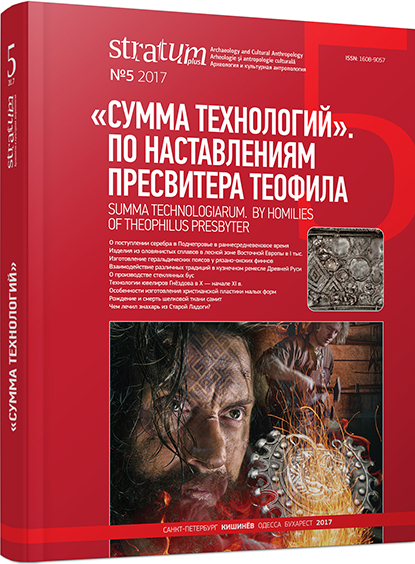Находки матриц для изготовления деталей геральдических поясов в древностях рязано-окских финнов
Matrices Used to Manufacture Elements of Heraldic Belts Found among the Ryazan-Oka Finnish Antiquities
Author(s): Ilya R. Akhmedov, Alexander P. GavrilovSubject(s): History, Archaeology, Middle Ages
Published by: Издательский дом Stratum, Университет «Высшая антропологическая школа»
Keywords: Eastern Europe; Early Middle Ages; the Finns of the Ryazan; military culture; the “heraldic” style; jewelry making belts; technology; cultural interaction; chronology; social stratification
Summary/Abstract: Matrices used to stamp elements of ‘heraldic’ belt sets in the 7th century were found in the area of the central group of the Ryazan Finnish sites. Plaques and pseudo-buckles embossed from thin silver or bronze plates were filled with lead alloy and fixed on belts with bronze brackets. These elements used to complement imported cast belt sets. Warrior belts among the steppe peoples in the Eastern Europe and their satellites were used to identify ranks: the type and the number of plaques pointed to the status of the belt’s owner. Additional embossed elements on a belt would thus render it a bigger importance. Other finds included embossed decorative elements of saddles, with analogies known in the Northern Caucasus. Excavations on Terekhovo hillfort yielded traces of local production activity (including the find of a defective belt plaque). Matrices were also found among the antiquities of the neighboring ‘Penkovka-Kolochin’ population and late ‘Moshchenki’ culture. The authors suppose that these technologies could be imported into the Middle Oka area from the Middle Dnieper area, to which the Penkovka-Kolochin population was connected; the latter supplied the Ryazan Finns with Dnieper, Danube and Byzantine imports. The matrices found in the Middle Dnieper area demonstrate the impact of Avar kaganate jewelry traditions from the Danube area, which was closely connected with Byzantium. To conclude, the remote impact of Mediterranean and Central European manufacturing traditions can be traced even in the farthest parts of Eastern Europe.
Journal: Stratum plus. Археология и культурная антропология
- Issue Year: 2017
- Issue No: 5
- Page Range: 17-39
- Page Count: 23
- Language: Russian
- Content File-PDF

